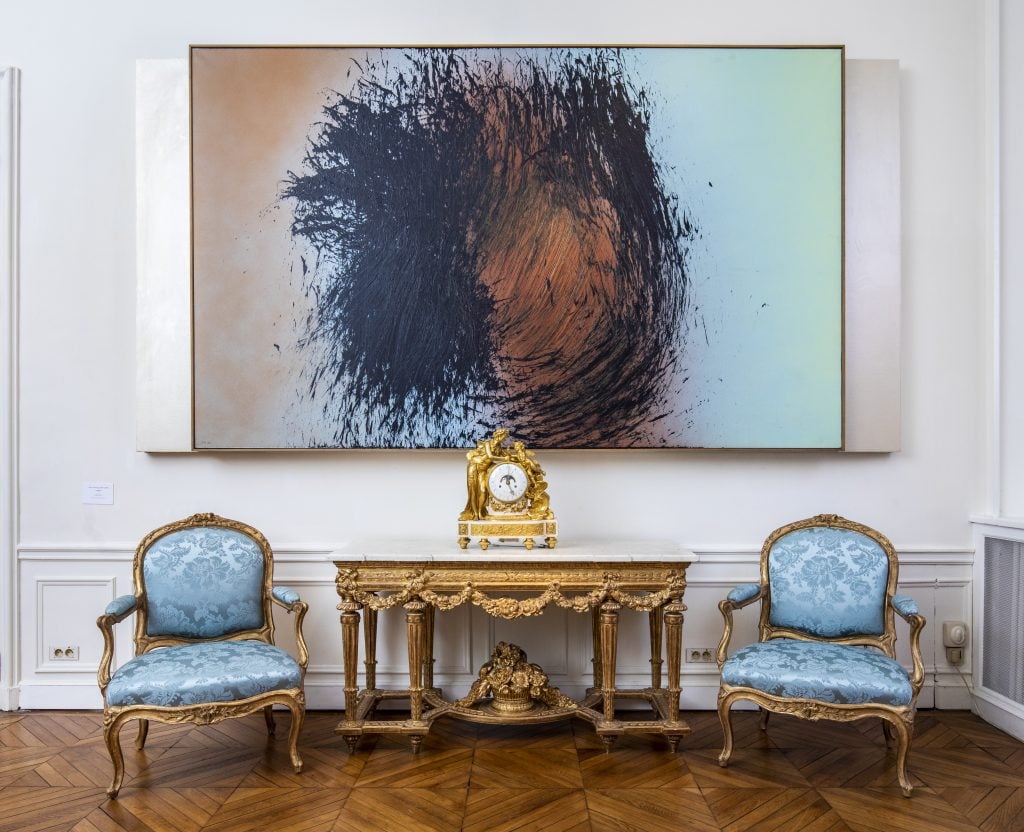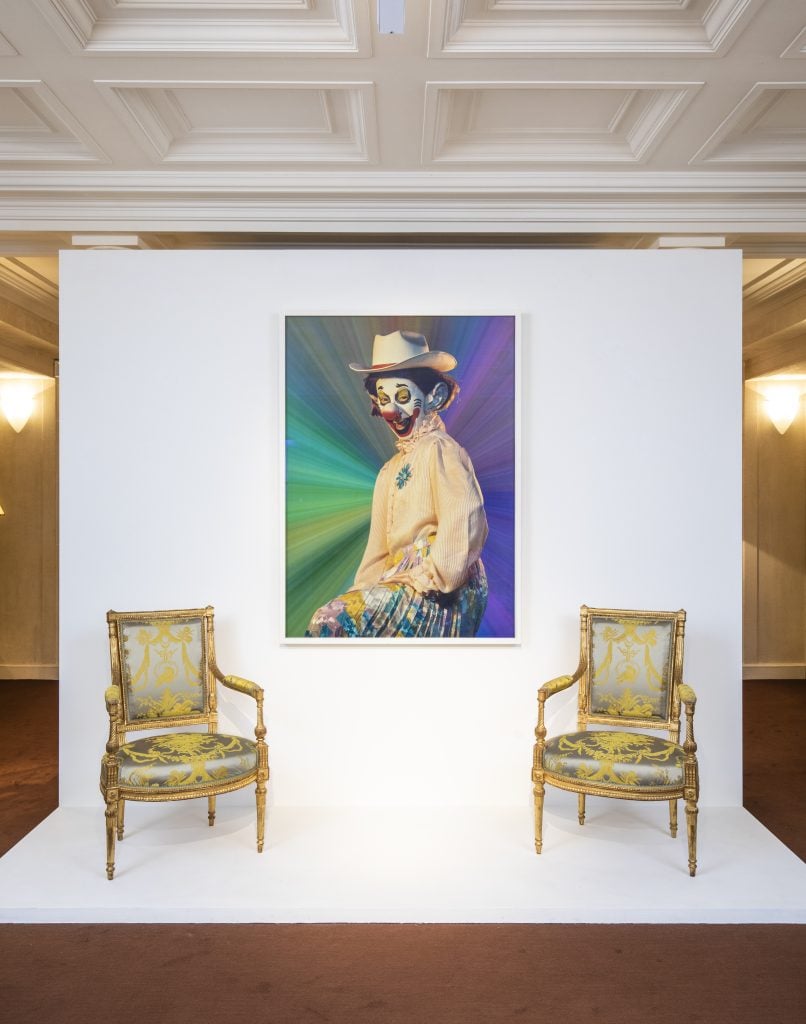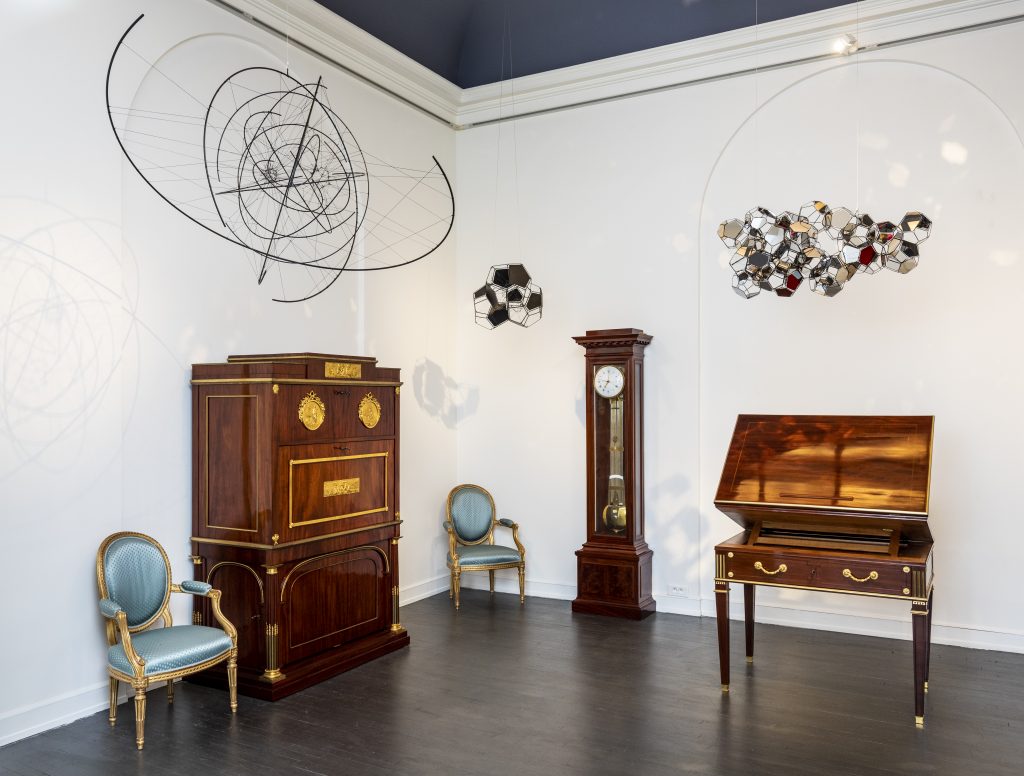Contemporary Art Exhibitions Are Drawing in a New Generation of Antiquities Collectors at this Historic Paris Gallery


Sophie Neuendorf

What is the right context for viewing an antique? In recent years, Paris’s historic Kraemer Gallery has been challenging the boundaries of where antiques belong and how they are enjoyed, showcasing priceless antiques amid masterpieces of modern and contemporary art by the likes of Hans Hartung, Olafur Eliasson, Fernand Leger, Takashi Murakami, Tomas Saraceno, and Sterling Ruby. These daring displays are one of a number of times Alain Kraemer has shown a flair for the unconventional as an art dealer at his family’s historic gallery (Established in 1875, Kraemer Gallery is the oldest family-operated gallery in Paris). Recently, Alain Kraemer offered us a peek inside his historic gallery space and tells us why antiques and contemporary art can be a match.

Installation view with Cindy Sherman’s Untilted #410 (2003) paired with Louis XVI giltwood armchairs stamped by G. Jacob. Courtesy of Kraemer Gallery.
Let’s start with a little about your career. You’ve worked with the famed antiques Masterpiece Gallery and now you’re working with your family’s gallery which opened in 1875. What has it been like working in such a historic métier?
It is a great pleasure to do this fascinating job and an honor to continue the family tradition that began with my great-great-grandfather. And there’s a wonderful challenge in continuing this great adventure with my brother Mikael and my cousin Sandra together representing the sixth generation of our family in this business. And, living with and showing these masterpieces of centuries past is an absolutely thrilling experience.
Even amidst all the opening and closing of space, you’ve gone ahead and organized a show of contemporary works at the gallery, which just opened recently. What convinced you to open an exhibition despite all the current uncertainty?
We opened in October when it was fully allowed—we didn’t want the pandemic to totally silence creativity and culture. So far, it’s been an excellent decision. The show has been incredibly successful and it has been one of the best exhibitions we ever organized—in fact, it’s making us eager to organize our next show.
As for what we have on view, right now we have two rooms filled only with works by Hans Hartung and Olafur Eliasson intermixed with 18th-century furniture. These two artists are among my favorites. We are also showing works by Takashi Murakami from the early 2000s as well as work from Cindy Sherman’s “Clowns” series, which is our wink to the excellent retrospective of her show at the Fondation Louis Vuitton. Cindy made very few happy clowns, and we have the pleasure to have a happy one. Really, who wants to see a sad clown at the moment?!
Our plan is to present a second version of the show with some new works that we hope to open in April 2021 depending on current measures. I cannot reveal too much, but we will have works by Pierre Soulages with Hitoshi Sugimoto, Tom Wesselman or Simon Hantai …

Installation view with late 18th-century mahogany furniture, an architect table (à la Tronchin) attributed to D.Roentgen and works by Tomás Saraceno. Courtesy Kraemer Gallery and Studio Tomás Saraceno
How did you choose which contemporary artists you want to show in the gallery?
We worked with the talented and very aware art advisor Laurence Dreyfus from Chambre à Part. She has an excellent eye for contemporary art. First, we chose the contemporary pieces, and afterward, we complemented them with a selection of furniture and objets d’art from our gallery. The process is always a collaborative conversation and we always want to show the best works by the best artists. We both really like Hartung, Shermann, Eliasson, and Fabienne Verdier, and started there. And after that, we added other artists that we loved, such as Edmund de Waal, Claire Tabouret, and Sam Falls. We sold a great part of the show that even inspired some young collectors including not only the contemporary pieces but also antiques.
How have your clients reacted to the exhibition?
They were very excited. We made sure to present the work in a very elegant and uncluttered way. For us, these exhibitions are a great way to attract young collectors with works by contemporary artists such as Saraceno, Sherman, and Eliasson. Then they end up really enjoying our presentation of furniture, clocks, ormolu-mounted objects, firedogs, and cabinets. We can open up a new world for them.
How have you managed to keep your gallery open despite the pandemic?
We are lucky to have a very large space, so we were able to welcome visitors while adhering to physical distancing. Everyone wears masks. But we also offer appointments to give our clients exclusive and private access as well.
Right now the gallery is showcasing contemporary pieces alongside antique masterpieces. Why did you decide to mount this exhibition? Is this the first time you’ve done such a juxtaposition?
We first started showing 18th-century furniture and objets d’art alongside works from different eras about 20 years ago, first showing antiques alongside Impressionist paintings and works by Modern artists such as Mark Rothko.
In 2015, we began displaying antiques alongside contemporary work with exhibitions celebrating our 140th anniversary, which included artists like Anish Kapoor, Lee Ufan, and Daniel Buren. We branched into showing street artists too, with works by Banksy, Shepard Fairey aka OBEY, Space Invader and Vhils. And we’ve also exhibited 18th-century furniture and objets d’art with paintings by George Condo.
Recently, we’ve created a presentation space in several rooms of our gallery so that art lovers can see how we would harmonize antique furniture in a contemporary setting and today’s decor. And that seems to be effective. Recently, one young couple who had never bought any 18th-century furniture suddenly fell in love with a pair of armchairs that were exhibited in a classical period room of the gallery. They wondered if it would fit well in their loft. We moved the pair of armchairs to one of our new setting rooms. They bought them immediately and are thrilled with this first purchase of 18th-century art.

Installation view at Kramer Gallery with Olafur Eliasson’s Youth (2019) and Your Vanishing (2011) paired with a Louis XVI desk stamped by P.Pioniez and a Louis XV giltwood sofa stamped by J-J.Pothier. Courtesy Olafur Eliasson and Neuggeriemschneider Gallery
What challenges have you faced in steering an antiquities gallery into the 21st century?
We must reinvent ourselves continuously and imagine new stagings and collaborations, especially with top-tier international contemporary art. At our gallery, we have staged some contemporary decor. In my opinion, 18th-century art and objects match contemporary art very well. Showcasing contemporary masters entices visitors who would not usually pass through an antiques dealer’s gallery door.
Your gallery is a family business: how do the older generations feel about combining antiques with contemporary art?
My father and my uncle have always been very open-minded. They gave us a lot of freedom, creativity-wise. I believe it’s very important to keep an open mind in life, and even more so in the art world.
How do you believe this crisis will affect galleries globally?
It’s a terrible crisis for many businesses. I don’t believe in exclusively online viewing—the in-person experience is paramount. It’s the only way to experience the soul of a work, whether antique or contemporary. Looking to the future, we will be part of the Art Paris VIP Program along with the Musée Carnavalet and the Paris Pinault Collection openings. We’re honored to be included alongside such important actors of the art scene but above all, it’s great to see that arts and culture are persevering despite the pandemic.